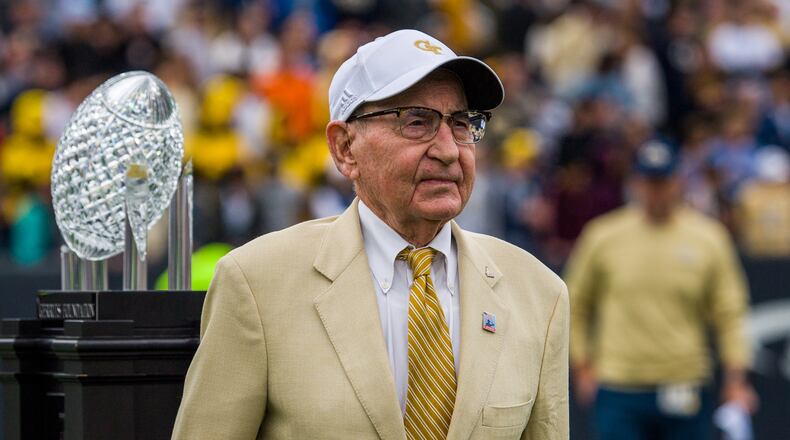A singular figure in Georgia Tech’s athletics history, Homer Rice will be honored Friday with the unveiling of a statue in his likeness on Callaway Plaza outside Bobby Dodd Stadium.
Rice, who served Tech as athletic director from 1980-97 and was the architect behind some of the Yellow Jackets’ greatest sporting days, will become the third person honored by Tech’s athletic department with a statue, joining legendary football coaches John Heisman and Bobby Dodd.
Considering his contributions, “it definitely seemed like the right thing to do and something we definitely wanted to celebrate,” athletic director Todd Stansbury told the AJC.
Rice, 94, will be on hand for a ceremony at which Stansbury and former football coach Bill Curry are scheduled to speak. Dozens of guests, including former Tech staff, coaches and athletes, are expected to attend, along with past students from the leadership class he has taught at Tech from the time of his retirement as AD in 1997.
When Rice assumed the AD position at Tech in 1980, the department was in dire shape. The school had recently joined the ACC, but facilities were substandard and the teams were uncompetitive. In his tenure, his hires included basketball coach Bobby Cremins, football coach Bobby Ross, baseball coach Jim Morris (and his successor Danny Hall) and golf coach Puggy Blackmon (and his successor Bruce Heppler). He also arrived at Tech shortly after the hire of Curry and was instrumental in his success.
Rice also developed the women’s varsity program and led fundraising efforts that brought in more than $100 million to the athletic department.
In all, coaches hired by Rice have won no fewer than 33 ACC titles, the vast majority of those won by Tech teams. Two of Tech’s greatest athletic achievements, the 1990 football national championship and the 1990 Final Four appearance by the basketball team, happened under his watch.
In an interview in 2020, Ross said that Rice “was always a wonderful human being and was a wonderful man to work for.”
While Rice could handle any problem that cropped up for his coaches, Ross appreciated that Rice let him do his job, even though, as a successful football coach, he could well have chosen to offer his input.
When heat grew on Ross early in his tenure, Rice protected him from it, Ross said. Ross recalled one practice before the Yellow Jackets broke through in his third season, when every coach from every other team showed up as a demonstration of support.
“I never had that anywhere (else),” Ross said. “I think Homer Rice’s presence fostered that type of thing.”
But perhaps Rice’s greatest legacy has been the Total Person Program, which has equipped thousands of Tech athletes with life skills, such as leadership and professional development and personal growth and wellness, that have served them well past the end of their athletic careers. The program has been replicated throughout college athletics and was adopted by the NCAA.
As Stansbury is fond of pointing out, Rice’s contributions to college athletics are duly recognized by the fact that the lifetime achievement award presented by the LEAD1 Association, the national association of athletic directors at FBS schools, is named after Rice.
“Just the focus on the student-athlete and the Total Person Program and nutrition and all the things that now we kind of take for granted nationally as just part of being a student-athlete – those were novel ideas in the early ‘80s, and they all came from him,” Stansbury said.
Stansbury arrived at Tech as a freshman football player in 1980, the same year that Rice was hired. Rice later hired him to be an academic adviser for the football team and continued to mentor him. Stansbury said that Rice’s greatest strength was his vision.
“And so I had a front-row seat to the evolution of Georgia Tech athletics from where it was in the early ‘80s to, obviously, what it became kind of the late ‘80s, early ‘90s,” Stansbury said, “and just seeing the impact a visionary leader can have on an organization, where you go from an institute looking at whether football and Division I athletics actually belongs to winning a national championship in football and Final Four in basketball.”
Rice’s contributions to Tech were only part of a most exemplary career. In his coaching career, he developed four All-American quarterbacks and is likely the only person to be the head coach of teams at the high-school, college and NFL levels in the metropolitan area of the same city (Cincinnati). He is credited with the invention of the triple-option offense. As a high-school coach for 10 seasons in Tennessee and Kentucky, he won just shy of 90% of his games. He served in the U.S. Navy in World War II, played minor-league baseball, earned a Ph.D. and wrote several books. He raised three daughters with Phyllis, his wife of 64 years, now deceased, and is now remarried, to Karen Sue Rice.
The bronze statue, about 7 feet in height, was designed by Don Haugen and Teena Stern Haugen, who also sculpted the kneeling Dodd statue on the plaza. It is a rare tribute for an athletic director. If there are other statues of athletic directors on other college campuses – not including the likes of Georgia legend Vince Dooley, whose primary contributions to the school were as a football coach – there can’t be many.
And, some might say, that’s the point in such an honor.
“He was a very special man, and I thought the world of him, I really did,” Ross said. “To this day I do. Very special.”
Daily Jackets: The AJC presents a daily look at one news item about Georgia Tech athletics to start your morning.
About the Author
Keep Reading
The Latest
Featured


